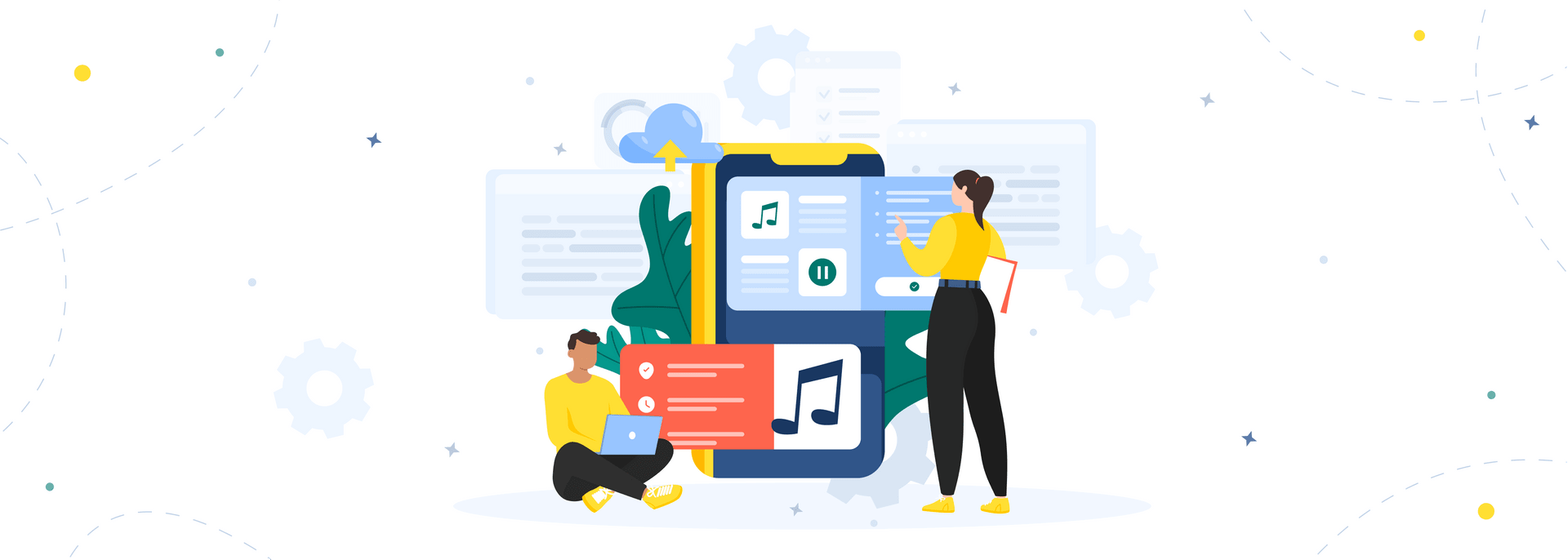It wouldn’t be far-fetched to say that everyone enjoys music. Well, almost everyone. Roughly 7.11 billion people listen to music, spending an average of 961 hours and 10 minutes per year on this activity. Considering this, it should come as no surprise that many want to learn how to make a music app and capitalize on such demand.
If you’re among them, this article is for you.
As a company specializing in media and entertainment software development, AnyforSoft is here to guide you through the audio streaming app creation process. In this article, we discuss all the crucial factors you need to consider to build a successful software product.
Enjoy!
Music Streaming Market Overview
Before diving into music streaming app development, let’s look at some curious market statistics:
- The market is expected to reach $18.56 billion by 2027.
- Music streaming applications are projected to amount to 1.12 billion users by 2027.
- By share of subscribers, the current music industry leaders are Spotify (30.5%), Apple Music (13.7%), Tencent Music (13.4%), Amazon Music (13.3%), and YouTube Music (8.9%).
- Music streaming apps generated $25.1 billion in revenue in 2021, which is a 32% increase compared to the prior year. Almost half of the revenue came from the United States.
- 82.1 million Americans have a paid subscription to at least one audio streaming app. Interestingly, the main reason for subscribing is to avoid ads while streaming.
- Paid subscriptions account for 78% of streaming revenue. As for ad placement, it brings 13% of revenue.
As you can see, the music streaming market is flourishing so if you manage to create an application that stands out from the competition, you will definitely get your share of the pie.
Now it’s about time we discussed how to make a music app like Spotify and Apple Music.
How to Build a Music Streaming App in 5 Steps
Building a music streaming app generally requires the following steps.
Step 1: Conduct the project discovery and choose the right type of music app
Any software project should start with the discovery phase. In simple terms, the discovery phase is the process of market analysis and research that is carried out before the development process. Its main goals are to identify your target audience and understand their needs to create a music streaming app accordingly.
The discovery stage will help you:
- Fine-tune your initial idea and get a clear vision of the future audio streaming app.
- Receive business and technical requirements.
- Estimate the cost to create a music streaming app.
- Define your monetization strategy.
- Meticulously plan development and choose an appropriate tech stack.
Based on your research, you should decide on the type of music app.
Types of music apps
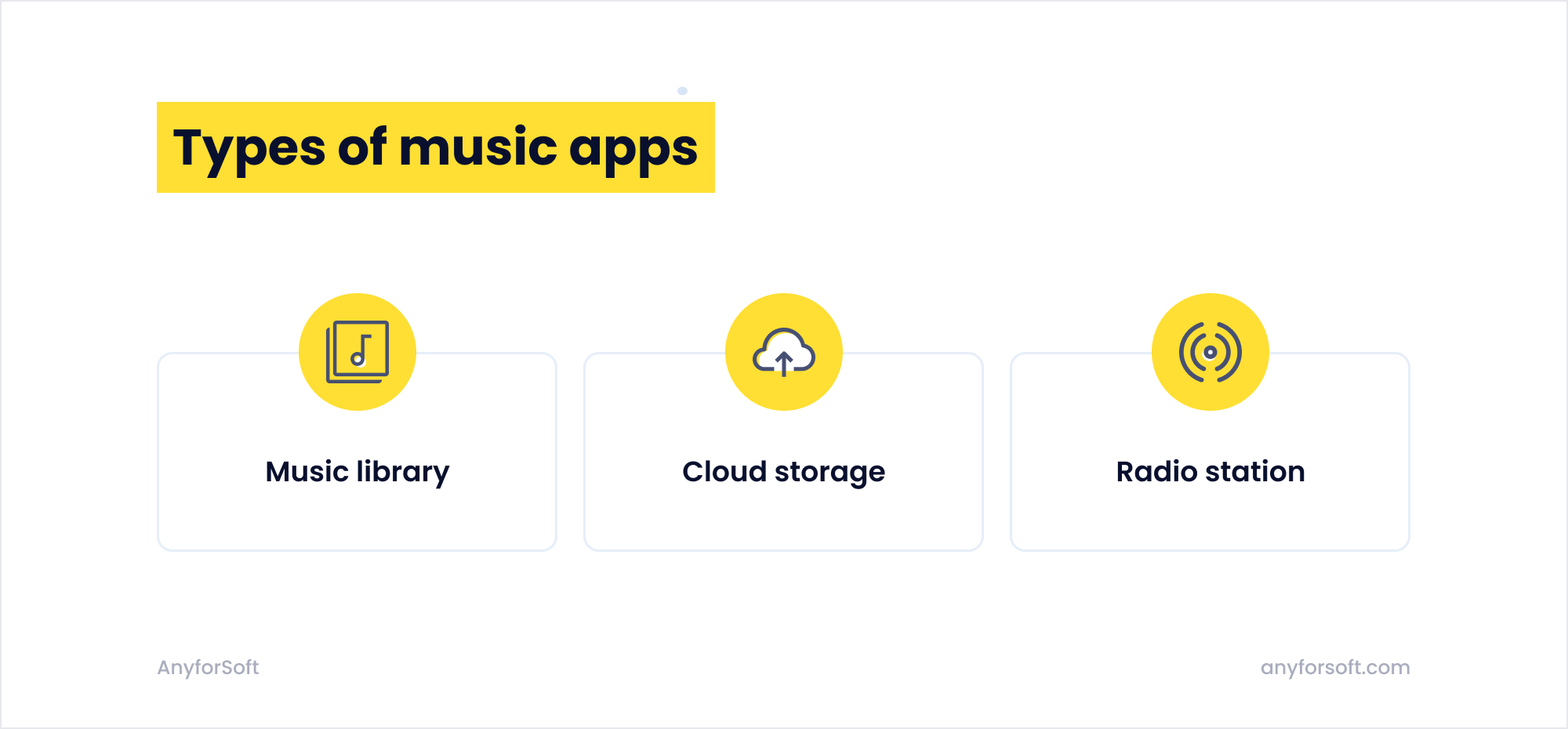
While doing market analysis, you will encounter the following music app types:
- Music library. A music library is basically an app that stores its audio files in server-based libraries, allowing users to access them under the app owner’s conditions. Spotify, Apple Music, YouTube Music, and many other music streaming services fall into this category
- Cloud storage. Such applications allow users to store, organize, and manage audio files on cloud storage. Audiobox, Beat, CloudPlayer, and pCloud are cloud storage applications.
- Radio station. The name is pretty self-explanatory. These apps enable users to stream various radio stations arranged by moods, genres, artists, and other parameters. iHeartRadio, AccuRadio, Shoutcast are some examples of such applications.
In this article, we focus primarily on music libraries, since they are the most common.
Once you know what type of app you need, the next step is to plan out your app features.
Step 2: Plan out the app features
If you want to build a music streaming app that can withstand the competition, you can’t do without advanced features. Your app’s functionality is what defines its success, so each function must be planned in minute detail. Given that, we will devote a significant part of our article to this topic.
Music discovery features
The first feature you should consider is music discovery. Music discovery will help your app users find new music, directly impacting listener retention, engagement, and, of course, your revenue. The idea behind it is very simple: the more time music lovers spend in your application, the more money you make. And to motivate them to linger, you should make it possible to discover new songs fast and efficiently.
There are several ways to achieve that.
Recommendation algorithms
When making a music app, you should develop a smart recommendation algorithm that will suggest songs to users based on their preferences and behavior. For example, if a user liked several songs by the same artist, the algorithm could detect this and recommend new content from this artist to them in the future.
The industry leaders (Spotify, YouTube Music, Apple Music) power their recommendation algorithms with AI technologies, which makes them highly accurate. Spotify’s algorithm, for one, analyzes three main parameters when determining what content to recommend: lyrics and language, song features (tempo, key, etc.), and a user’s past listening habits. By the way, if you want to build AI for your own music streaming app, you should opt for Python development services.
Charts
Every major music streaming service has charts. For example, YouTube Music allows you to explore the top 100 songs in each country. That is a great opportunity for users to discover new content while getting an idea of what’s currently trending. This also benefits artists, as by appearing in charts, they attract new listeners. So to create an app like Spotify or YouTube Music, definitely consider implementing the charting functionality.
Playlists
Your music application should contain playlists with songs sorted by artists, moods, and genres. That will help listeners find new music based on their current mood or genre preferences. You could also create playlists for different events/situations. For example, Spotify offers playlists for workouts, meditation, productivity, and so on. Given that many people do various activities with music in the background, having playlists for different occasions definitely won’t hurt.
Search bar
Virtually all music streaming apps have search bars, enabling users to quickly find a song/artist/album they’re interested in. The industry leaders go as far as adding some killer features to their search fields. For example, Spotify has a song identification feature implemented into its search engine. When a user wants to find a specific song but doesn’t know its name, they can type a line from it into the search bar, and the app will return songs that contain the specified line. You should agree that it is very convenient and useful.
Artist profiles
Your app should have a profile page for each artist so that a listener could visit it and explore the artist’s songs, albums, new releases, playlists, top-performing songs, and other content.
Music player features
The top secret music streaming industry leaders don’t want you to know: an audio streaming app must have a built-in music player. Shocking, isn’t it? Jokes aside, your player should be simple yet efficient, allowing users to quickly navigate through their favorite tracks. Ideally, it should be able to buffer content quickly so that your application could be used even with a slow internet connection.
Now let’s discuss the player’s features:
- Navigation buttons. That’s kind of obvious, but we still have to mention it. Play/pause, rewind, next song, previous song, loop song, shuffle songs—these buttons are a must-have for every music player.
- Lyrics. Another cool feature you could add is lyrics. For example, YouTube music uses LyricFind to provide lyrics for many songs in its library. That’s highly convenient because it allows users to access song lines without having to open a browser and find them manually. Besides, many people learn languages by listening to foreign songs, so having the lyrics feature built-in in your player will help engage them.
- Share button. People tend to share music tracks they like with their friends and family. By doing so, they also promote music applications they share songs from, so adding a share button will definitely benefit your product.
- Other buttons. You should also consider adding the following buttons: add song to library, report, like/dislike, add to queue, remove from queue, go to artist, go to album, and so on.
The player should be designed in such a way as to be fast and responsive. So try to keep it simple and don’t develop some fancy features at the expense of performance.
Offline mode
Another important feature to keep in mind when creating a music streaming service is offline mode. Of course, most people nowadays have unlimited access to the internet, but still, there are many situations where you can’t use Wi-Fi or a cellular network.
Let’s say you’re driving back home from a trip to a picturesque rural area and want to listen to “Take Me Home Country Roads” by John Denver. However, as you take your phone out, you notice the *no cell service* message. Pretty unpleasant, isn’t it?
Fortunately, such a situation would never occur in real life, as every major audio streaming app supports offline access. Spotify, YouTube Music, Apple Music, and multiple other applications allow you to download songs from their libraries and listen to them while offline. By the way, in Apple Music and YouTube Music, this feature is available to subscribers only, which is yet another good way to encourage listeners to subscribe and thus make a profit.
Considering the above, you should create a music app with the offline mode feature in order to not lag behind your competitors.
User profile and library management
Once a user signs in, they should be able to access their profile. In the profile section, they should be able to manage their libraries: create, delete, and edit playlists, explore the songs they liked, add tracks to the play queue, and so on. For example, in Spotify listeners can access the list of the songs they enjoyed the most in the current month and play them, which is pretty convenient. Since we already mentioned some of the library management features above, let’s move on.
Other features to consider
Here are additional features to consider when developing a music streaming application:
- Push notifications. Push notifications are a great tool to encourage listeners to spend more time in your app. For example, you could send a notification to a user whenever their favorite artist releases a new single or album.
- Song identification. It would be convenient if your app could identify songs and locate them in the music library. As mentioned above, Spotify has a similar feature that allows users to search for a song by simply typing a line from it into the search bar.
- Voice commands. Another interesting feature is voice commands. For example, you could enable your app users to navigate the application with their voices. They could say something like “Play my country song playlist,” and your app would instantly do that.
- Social playlists. By introducing social playlists (also called collaborative playlists), you will make your music streaming application more interactive. Spotify supports such a feature, enabling users to create playlists together.
- Ticket selling. You could sell tickets to concerts directly in your app. For example, you could parse data from ticketing marketplaces via API and place affiliate links to them. That could prove to be a great source of additional revenue.
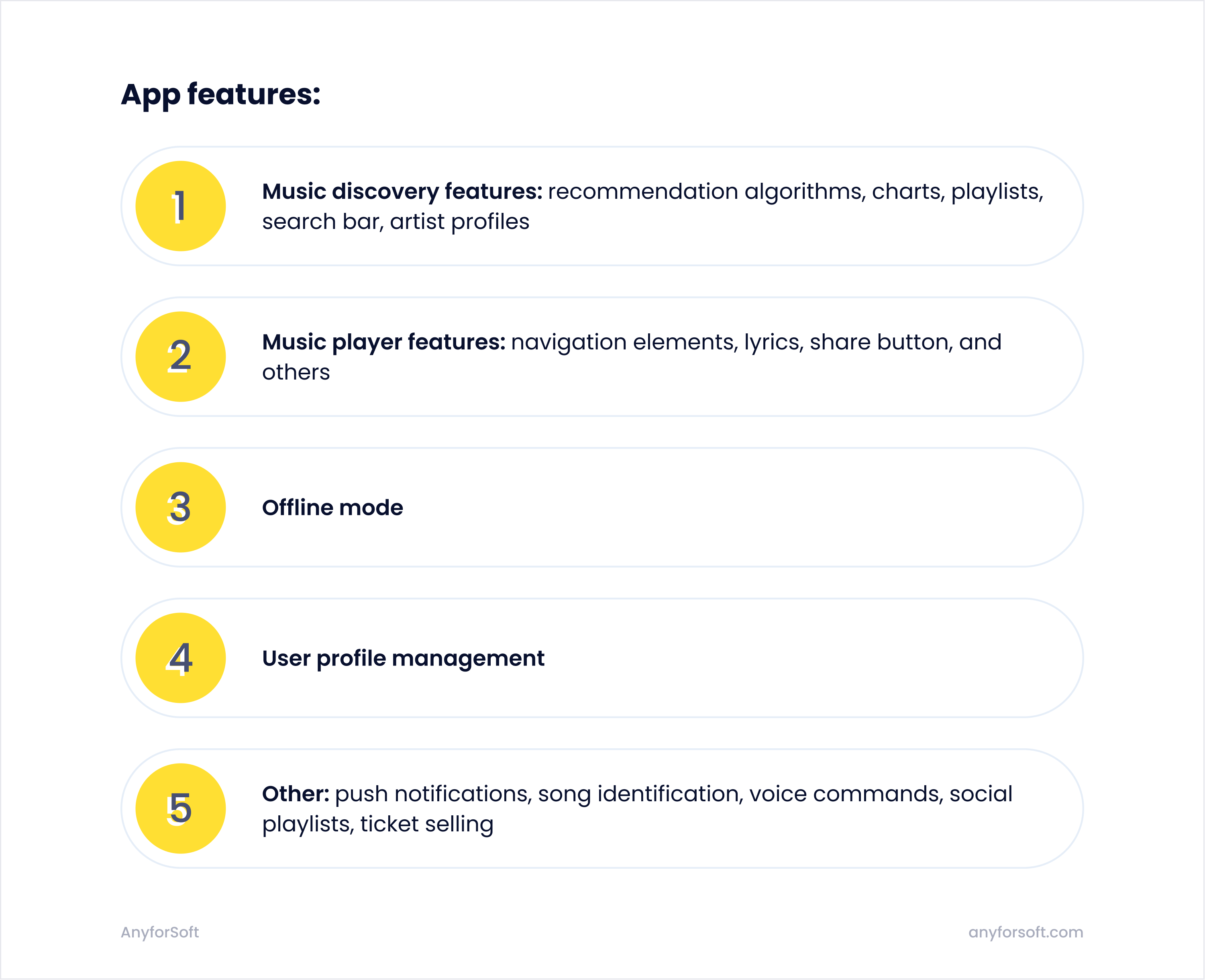
Now that you know what features to develop, let’s finally move on to the next step.
Step 3: Create UI/UX design and start development
So you’ve conducted market research, decided on the type of app to build based on its data, and planned out all the features. The next step is to carry out UI/UX design and development. From this point, you can proceed with your development team (if you have one) or hire developers for your startup.
UI/UX design stage
How to create a music app with a user-friendly design? The main principle here is to not overdo it. If you examine apps such as Spotify, Apple Music, Youtube Music, or similar solutions, you will notice that all of them have very simple designs that focus on user experience and performance rather than visual appeal.
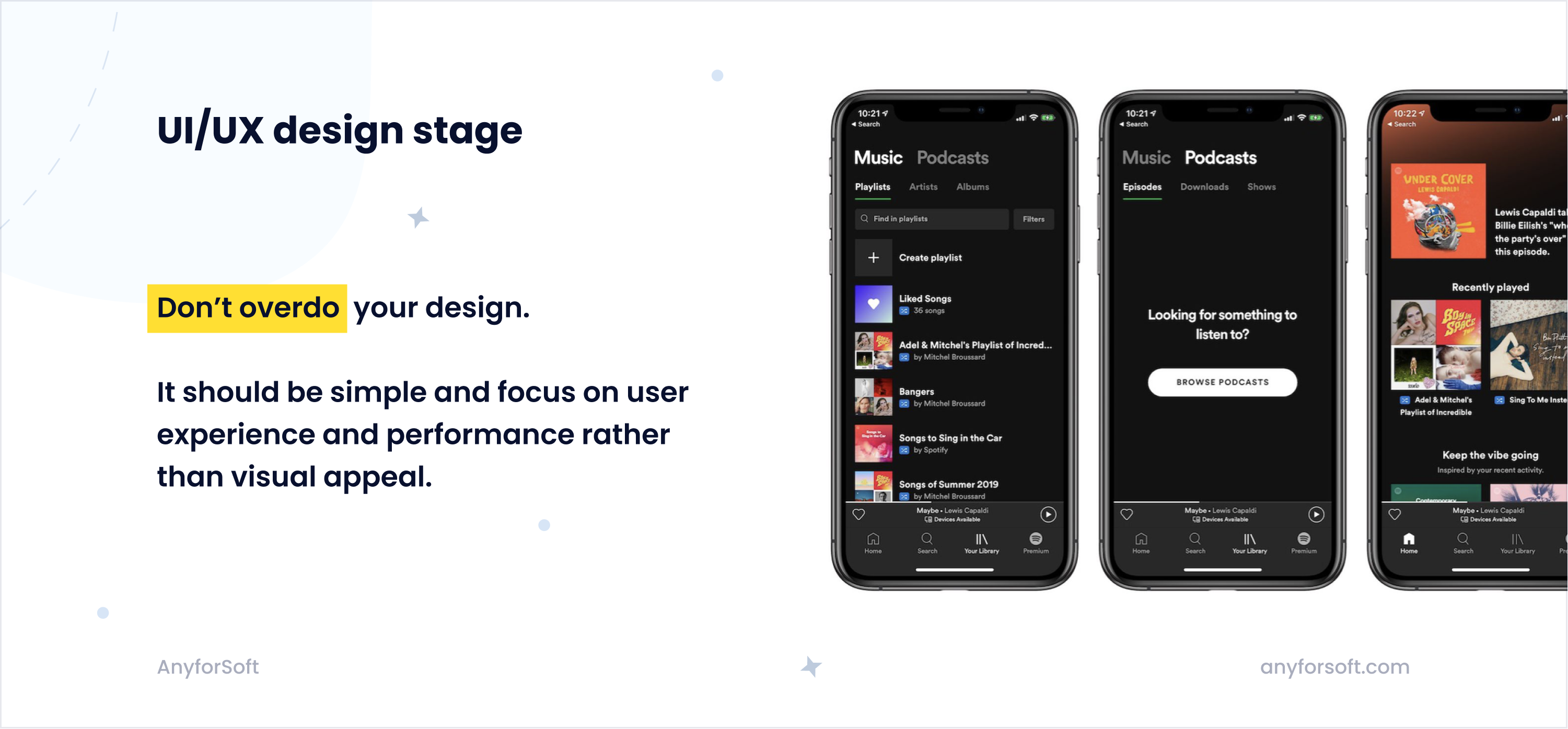
In our recent article on educational app design, we also discussed what good design in general should be. Let us repeat the key points from there. So good design:
- Adapts to different screen resolutions and operating systems.
- Has straightforward navigation without superfluous elements.
- Loads fast on any device and doesn’t require too many resources.
- Is unobtrusive (without ads or pop-ups that cover a big portion of the screen, distracting users from enjoying their favorite songs).
- Is user-intuitive.
It typically takes up to 150 hours for designers to create UI/UX elements for one platform. The design process might include the following stages:
Wireframing. A wireframe is a sketch of the app’s interface that specifically focuses on space allocation and prioritization of content, available features, and intended behaviors. It shows general design concepts. Wireframes are typically black and white and don’t include any graphics.
Preparing mock-ups. Mock-ups are static representations of an application that show how it will look. They contain logos, images, color schemes, navigation buttons, and other elements that will make up the final product’s design.
Prototyping. In the prototyping phase, the design team creates an interactive model of the future music application so that you can explore how the app works and reacts to different user behaviors.
Development stage
In the development stage, your team or a third-party development company builds your music app and builds all the required features. The choice of tech stack will be dictated by your app's complexity, technical requirements, the platforms your target (desktop, iOS, Android), and other factors. The development of a complex app requires a high level of expertise in various programming languages and frameworks. For example, here is a tech stack that was used to create Spotify.
Considering this, we advise you to be extremely picky when looking for music app developers.
Development cost
So what about development costs?
Unfortunately, it’s impossible to accurately estimate the end product cost without having a look at your project first. Thus, if you want to find out what budget you need, you can always contact us and ask for a quote.
However, we do can provide you with approximate estimates.
The cost typically depends on the project’s complexity, number of features, tech stack, target platforms, and other parameters. Thus, the development of a simple app for one platform requires a $30,000 to $70,000 investment and takes 3 to 6 months. When it comes to more complex solutions, they might require $70,000 to $100,000 and take 6 to 8 months. And highly complex music streaming apps with sophisticated recommendation algorithms and other advanced features cost between $100,000 and $250,000 and take 9+ months to develop.
Step 4: Test your application
To make a music streaming app, you shouldn't forget about quality assurance. QA testing usually takes place alongside development. While developers build features and work on the app’s architecture, QA engineers thoroughly test everything and create bug reports. Quality assurance is a complicated process aimed at verifying that the application performs as intended, as well as ensuring that it meets the user's expectations.
It typically includes the following stages:
- Functional testing—to test the app's basic functionalities, such as searching for music, creating playlists, playing music, navigating through songs, and so on.
- Compatibility testing—to ensure that the app is compatible with different devices, operating systems, and web browsers.
- Performance testing—to verify that the app can handle a large number of users, music streams, and playlists without any performance issues such as slow loading times or crashes.
- Usability testing—to test the app's user interface along with user experience and ensure it is easy to navigate and understand, and the app is user-friendly.
- Security testing—to check the app's security measures, such as data encryption, secure logins, and protection against hacking attacks and malware.
- Integration testing—to test the app's ability to integrate with other third-party applications, such as social media platforms, voice assistants, messengers, and other software.
- Regression testing—to ensure that new updates or changes to the app do not affect its existing functionality.
You should never neglect the quality assurance stage when it comes to building your own music app. If you release it without proper QA measures, the end product will definitely contain lots of bugs, which will spoil the user experience for your customers. Remember: it is extremely hard to fix a bad first impression, so if you don’t want to lose clients, QA is a must.
Step 5: Acquire the necessary licenses
Normally, after the quality assurance phase, you just release and deploy your application. However, it’s not the case with music streaming services. To stream music, you are required to obtain various licenses. Failing to do so will result in huge fines for your business.
There are many licenses associated with music streaming, and which licenses you need will depend on your country as well as your app’s type and its specifics. Thus, we advise you to consult with a lawyer to avoid potential problems.
In general, the most common licenses required for streaming web and mobile apps are the following:
- Master rights. This license provides the rights to the actual recording of a song, including the right to reproduce, distribute, and perform the song. This type of license is usually owned by artists or their record labels (Warner Music Group, Sony Music, etc.).
- Publishing rights. This license provides the rights to the song itself: its melody, lyrics, and arrangement. Publishing rights are usually owned by a songwriter and/or composer.
- Performance rights. As the name suggests, this license grants you the right to perform a song publicly. It is required for applications that offer live streams or on-demand music streaming. This license is usually administered by performing rights organizations (PROs), such as BMI, SESAC, ASCAP, and so on.
How to Start a Music Streaming Service: Monetization Models
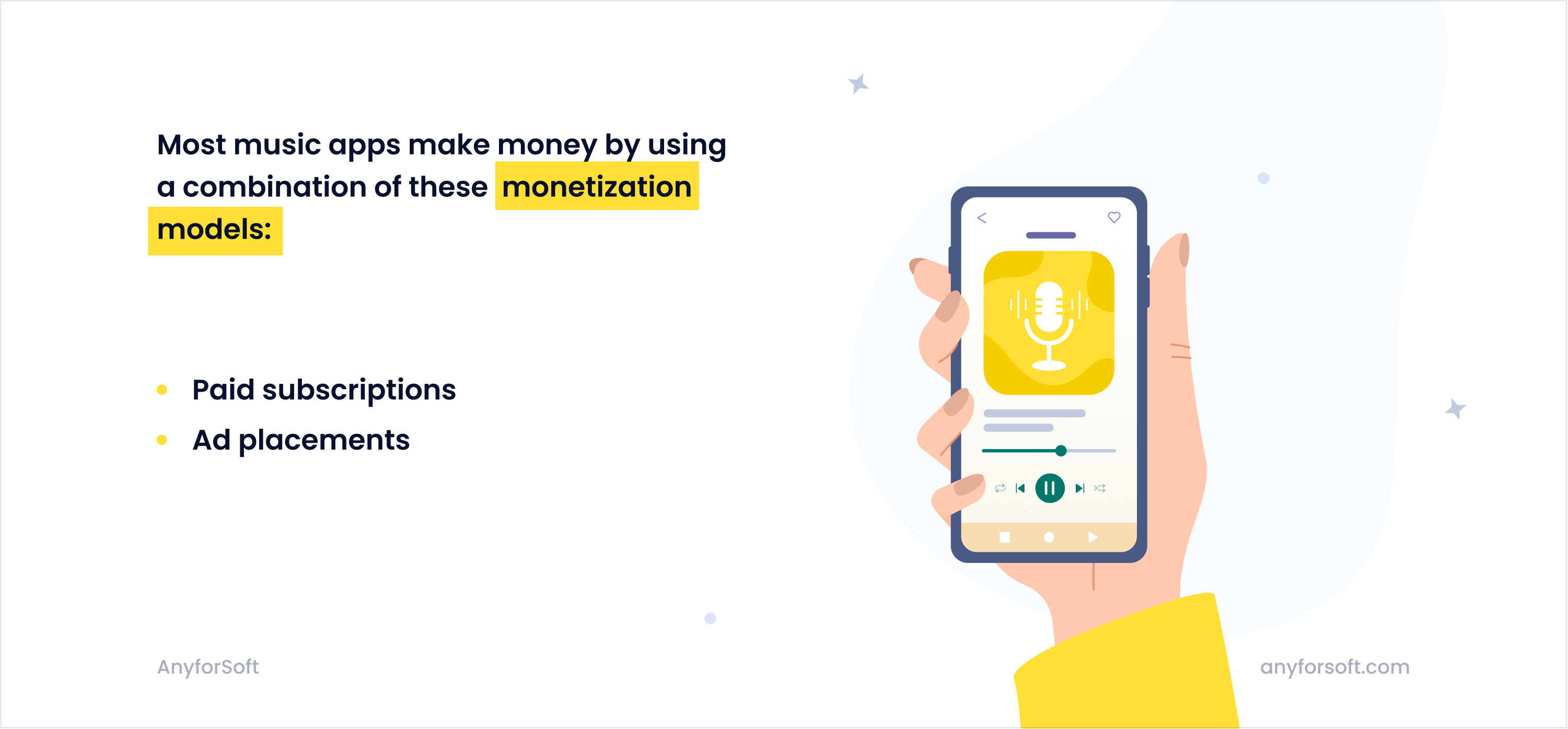
Now that we’ve discussed in detail how to create a music streaming app, we want to talk about the last detail, which is monetization models. Music services make money in multiple ways, but the most common are paid subscriptions and advertisement placements.
If you read attentively, you know that paid subscriptions account for most of streaming revenue. Given that, music applications generally rely on this method. They offer their content for free but hide premium features behind a paywall. For example, and here we once again repeat ourselves, YouTube Music’s offline mode is available only to premium subscribers. There are many ways to encourage your audience to subscribe, but that’s a topic for another article.
As for advertisements, music streaming apps typically place audio ads from advertisers. For example, if you used a free plan in Spotify, you might have noticed that once you navigate through songs, an ad might play. Once your app gains popularity, you will also be able to generate revenue with this method.
Conclusion
We hope this article has cleared things up for you, and now you understand how to create a music app from scratch. As you can see, the development of such a solution is highly complicated, and the music streaming market is very competitive. Thus, don’t expect that you can just release a mediocre product and profit from it. To stand out from the competition and attract music lovers, you need a high-quality app with a sophisticated recommendation system and unique features. And to develop such a solution, you should find a reliable and, most importantly, experienced development partner.
AnyforSoft could become that partner.
We have over 10 years of experience in developing solutions for the media and entertainment industry. The knowledge of the best industry practices along with the implementation of the latest technologies allows us to create software of any complexity. As a customer-oriented company, we treat our client’s projects as our own, always striving to meet the expectations and needs of everyone who we work with.
Contact us today, and let’s discuss your project!
FAQs
It depends on the country you start the app in, the type of software you create, and its specifics. In general, you might need the following licenses:
- Master rights. This license provides the rights to the actual recording of a song, including the right to reproduce, distribute, and perform the song. This type of license is usually owned by artists or their record labels (Warner Music Group, Sony Music, etc.).
- Publishing rights. This license provides the rights to the song itself: its melody, lyrics, and arrangement. Publishing rights are usually owned by a songwriter and/or composer.
- Performance rights. As the name suggests, this license grants you the right to perform a song publicly. It is required for applications that offer live streams or on-demand music streaming. This license is usually administered by performing rights organizations (PROs), such as BMI, SESAC, ASCAP, and so on.
It depends on the country you start the app in, the type of software you create, and its specifics. In general, you might need the following licenses: Master rights. This license provides the rights to the actual recording of a song, including the right to reproduce, distribute, and perform the song. This type of license is usually owned by artists or their record labels (Warner Music Group, Sony Music, etc.). Publishing rights. This license provides the rights to the song itself: its melody, lyrics, and arrangement. Publishing rights are usually owned by a songwriter and/or composer. Performance rights. As the name suggests, this license grants you the right to perform a song publicly. It is required for applications that offer live streams or on-demand music streaming. This license is usually administered by performing rights organizations (PROs), such as BMI, SESAC, ASCAP, and so on.
Complex apps typically require 9+ months to develop. Speaking of such sophisticated software as Spotify, it might take even longer. Plus, don’t forget about software maintenance and support which is supposed to be provided as long as the product exists.
Complex apps typically require 9+ months to develop. Speaking of such sophisticated software as Spotify, it might take even longer. Plus, don’t forget about software maintenance and support which is supposed to be provided as long as the product exists.
This heavily depends on the type of software you build and its features. For example, if you want an app with AI-based recommendation algorithms, you should opt for Python. Spotify, for one, was created with Python and Java as well as multiple frameworks. You can scroll the page up and explore all the technology solutions that were used in the development of Spotify.
This heavily depends on the type of software you build and its features. For example, if you want an app with AI-based recommendation algorithms, you should opt for Python. Spotify, for one, was created with Python and Java as well as multiple frameworks. You can scroll the page up and explore all the technology solutions that were used in the development of Spotify.
